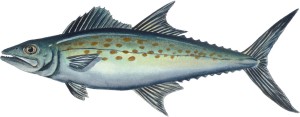The NSW Food Authority advises fishers to avoid eating Spanish Mackerel above 10kgs (as advised by NSW industry experts), as there is an increased risk of ciguatera poisoning.
 Commercial fishers, recreational fishers and consumers should not eat large Spanish Mackerel, as two recent ciguatera poisoning incidents involving 20kg and 40kg fish that were caught and consumed on the mid north coast have been reported in NSW.
Commercial fishers, recreational fishers and consumers should not eat large Spanish Mackerel, as two recent ciguatera poisoning incidents involving 20kg and 40kg fish that were caught and consumed on the mid north coast have been reported in NSW.
The Food Authority has been advised of an incident of ciguatera poisoning affecting 3 people after consuming a Spanish Mackerel caught off the coast of Crowdy Head late in March, and a second incident last week that affected one person who consumed Spanish Mackerel caught off the coast at Crescent Head. In both cases, the fish consumed were caught by recreational fishermen.
Similar outbreaks were reported 12 months ago on the mid north and far north NSW coast and the Gold Coast in Queensland.
More information on ciguatera poisoning can be found at www.foodauthority.nsw.gov.au/rp/fish-ciguatera-poisoning

